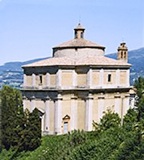


Bishop Angelo Cesi commissioned this church outside Porta Romana to house a 14th century image known Maestà delle Forche (of the gallows). This image was originally in an aedicule on the place of execution outside the city, and was used to comfort the condemned. In 1566, the people of Todi restored the image, and on the feast of Santa Croce in 1589, by a miraculous coincidence, many of them turned up to pray at the shrine. This event prompted Bishop Cesi to commission a new church to house the image. The local artist Pietro Paolo Sensini was appointed to direct the construction project at this time.
A number of architects submitted designs. That of the Perugian Valentino Martelli, which was based on the circular Tempietto di San Pietro Montorio, Rome, was judged to be the best. The image was moved temporarily to Sant’ Agostino in 1591, when Bishop Cesi laid the foundation stone. Martelli’s original design was however abandoned shortly after the laying of the foundations in favour of a Greek cross plan based on the Sistine Chapel in Santa Maria Maggiore, Rome. It seems likely that Martelli was associated with the new design: payments were recorded to him throughout 1989-92. Silvestro Nessi (referenced below) has suggested that he had also used this design for the church of Santa Maria della Consolazione, Montefalco in 1588.
Pietro Paolo Sensini is documented in Perugia with Valentino Martelli in 1592. Work began again shortly thereafter under Giovanni Domenico Bianchi (the architect responsible for Palazzo Cesi, Acquasparta). Ippolito Scalza, who took over in 1594, worked on the project until 1606, the year in which Bishop Cesi died. Work was suspended, and Ippolito Scalza was called back to the site in 1610 to advise on the construction of a “temporary” wooden roof. The sacred image was translated at this time to the site behind the high altar that it still occupies.
The community of Olivetans from San Silvestro took over the church in 1666, and they remained here until 1827. They built the present cylindrical dome when the temporary roof collapsed in 1748. The church was comprehensively restored in the period 1915-38.
Maestà delle Forche (14th century)
This venerated fresco was detached from a nearby wayside tabernacle in 1610 and is now in the apse. It depicts the Crucifixion with the Virgin, St John the Evangelist and angels. This image was restored in 1566 by a follower of Giovanni di Pietro, Lo Spagna, and (as noted above) a miracle associated with it in 1589 prompted the construction of the church.
St Charles Borromeo with angels (1616)
This altarpiece on the altar on the right is signed by Giovanni Baglione and dated by inscription.
Innocent III Confirms the Franciscan Rule (17th century)
This documented altarpiece by Andrea Polinori, which was on the altar on the left, was destroyed in ca. 1990.
St Charles Borromeo with SS Agnes and Apollonia (1614)
Text [Pietro Paolo Sensini]
St Laurence with SS Apollonia and Lucy (17th century)
Text [Pietro Paolo Sensini]
Read more:
S. Nessi, “Il Tempio della Consolazione di Montefalco”, Periodico dell’ Accademia di Montefalco , 18 (2004) 7-35 - see pp 18-22 for the relationship between this church and the Tempio del SS Crocifisso, Todi
Return to the Monuments of Todi.

